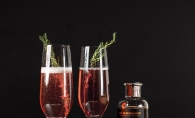
Popping the cork on a bottle of bubbly can fill a room with celebratory spirits. As we move into brunch season and springtime celebrations, let’s take a closer look at a Champagne’s lesser-known cousin, crémant.
With the same richness and body of Champagne, crémant (pronounced kruh-maant) brings the same party vibes—at a fraction of the price. To learn more about this sparkler, we spoke with The Wine Shop’s wine buyer Gary Seelen, who has Level 3 certification from the Wine and Spirit Education Trust.
What is crémant?
Crémant is the name used for sparkling wine made in the same method of Champagne—often called traditional or méthode champenoise in other parts of France [and Luxembourg]. The term Champagne can only be used for sparkling wines made in the Champagne region of France. Crémants often use the same grapes as Champagne, however, the grapes or blends differ by region. Single varietal or blend rules are set by the regions. The two most well-known [varieties], crémant d’Alsace … and crémant de Loire, [sometimes] blend in different grapes than those allowed in Champagne.
What’s the production process?
The traditional method was discovered in Limoux, France, in the Pyrenees more than 100 years before Dom Pérignon in Champagne, who often gets credit ... [Briefly, the process includes fermenting still wine, usually in a barrel, followed by bottling the wine and inoculating it to start a second fermentation.] As the second fermentation occurs, the creation of alcohol releases [carbon dioxide], but it cannot escape the bottle, thus creating the bubbles. Sparkling wines will age in the bottles on the dead yeast cells over time, where the bottles are partially turned in the racks (called riddling), creating the creamy texture you taste in traditional method crémants.
After aging on the dead yeast cells …
the necks of the bottle are frozen, the yeast cells [emptied], and a small amount of dosage—either more sparkling wine or sugar and still wine—is added back to top off the bottles.
Does crémant run sweet or dry?
It can be either. It depends on the amount of sugar added during dosage. The driest crémants will be topped with wine, no sugar added.
How does crémant differ
from Champagne?
[Crémant is] generally lighter, less PH, less acid and usually less time on the lees. [Lees are the dead yeast cells, mentioned earlier.]
How does crémant compare to prosecco?
Proseccos are made in large, sealed tanks with [carbon dioxide] added in-tank to help create bubbles. Crémants, similar to Champagne, are richer, creamier, less sweet and have a higher concentration of bubbles.
Does crémant have the ability to age?
They are meant to be [consumed] young; they will not age like Champagne, but three to five years is generally OK.
What is crémant’s optimal temperature?
All sparkling [wines] should be served around 45–50 degrees F, [the same temperature as Champagne].
How about food pairings?
I always want to demystify it, make it accessible to everyone. People should drink what they like with [the food] they like. However, there are some classic pairings. Oysters are usually number one in people’s minds, but other shellfish work well—lobster, scallops, crab. [You can also consider] nonstinky cheese
and salty foods, even potato chips.
Why isn’t crémant as well known?
Marketing—follow the money. The different regions that make crémants are more known for their still wines that can often age and can sell large quantities.
What are a few of your favorite crémants?
Alsace is number one for me—creamy and fresh with excellent rosé.
How does one shop for a crémant?
Ask your wine merchant for recommendations on what they carry. You can get great crémants between $15 and $25.
Buying Crémant Locally
Looking to give crémant a try? Local shop France 44 has several bottles under $30 from which to choose. “I love crémant for its ability to attain Champagne-quality status, while staying at a more affordable price point,” says France 44 wine specialist Karina Roe, who is a certified sommelier through the Court of Master Sommeliers and holds a Diploma in Wines through the Wine & Spirits Education Trust.
“I also love that crémant can be far more diverse than Champagne, from where it comes from in France to the grapes used,” Roe says. “It’s inspiring to discover the small family estates that are producing crémant around [France]—it adds to the unique history and traditions that France has in the sparkling wine world.”
Below, Roe shares her two favorite crémant picks from the France 44 selection.
J. Laurens Crémant de Limoux “La Matte” Brut Nature
“This incredible producer from southern France’s Limoux region has been a staff and customer favorite for years. This brut nature is bone dry but doesn’t skimp on flavor and texture. The blend is chardonnay, chenin blanc and mauzac, spending 24–36 months aging on the lees for a decadent, creamy texture.
Gustave Lorentz Crémant d’Alsace Brut Rosé
“The Lorentz family has been making wine in France’s northern Alsace region for nearly 200 years. Their gorgeous brut rosé crémant is made from 100 percent pinot noir—Alsace’s red grape specialty. Expect notes of fresh strawberry, bright red cherry and hints of lovely floral notes with a long finish.”
The Wine Shop, 17521 Minnetonka Blvd., Minnetonka; 952.988.9463;
wineshopminnetonka.com @wineshopminnetonka
France 44, 4351 France Ave. S., Mpls.; 612.925.3252; france44.com @france_44









